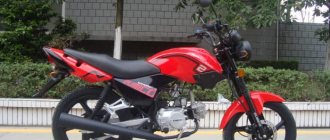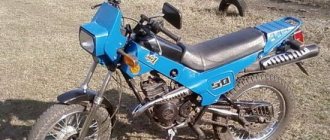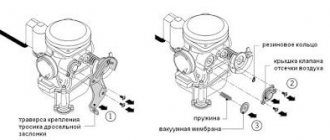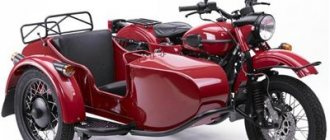motorcycle racers
Having started working with motorcycle racers - both amateur and professional motorcyclists - I can say that 95% show all the symptoms of classic overtraining: lethargy and lack of functionality, most often manifesting themselves in problems with endurance. Which is understandable: practicing motocross, and even more so related disciplines - enduro, country crosses, etc. - places significant demands on the body. And in a good way, a completely logical conclusion would be to think that at this level of stress, the body’s needs for nutrition and recovery will differ from the needs of a person who does not play sports.
Sooner or later, the body stops “pushing” such a regime, and instead of a full-fledged workout, it turns out something like this: we ride vigorously for two or three laps, then a couple of laps feel “nauseous,” then we go for thirty to forty minutes of conversation with other similar “messengers”... The classic reaction to the emergence of such a situation for a motorcycle rider who is not particularly striving for results is to reduce training simply to this form of pastime. Motorcycles – communication – barbecue – beer. The reaction of a motorcycle racer striving for results is not to think about why this is happening and to provide the body with resources and time to recover, but on the contrary - to increase training loads! A person begins to resist as best he can: crossfit is added to motocross training, swallowing raw eggs and running in the morning, weights, swimming... All this deserves respect for fortitude, but in most cases the body does not care about fortitude, and the result obtained is the opposite of the expected . If you recognize yourself in any of the things described, then my article is addressed to you.
Basic Concepts
“We are what we eat” is a phrase familiar to everyone. Simple, but for some reason its obvious meaning does not fall into the consciousness of most people. What else will we consist of, except what falls into us? Therefore, how our bodies will function directly depends on what we eat. There are three parameters, the combination of which determines the physical and functional components of our bodies;
- Diet: 60%;
- Training: 20%;
- Recovery: 20%;
Through training, we give the body the direction in which it needs to change. Through diet we provide him with the building resources to carry out these changes. By restoring, we provide the body with the opportunity to carry out these changes. Lack of attention to any of these parameters leads to a deterioration in the final result obtained. Proportional to their percentage in it. This scheme can be imagined as building a house in which the building materials are what we eat. Workers, foremen and engineers are our training; the workdays of these workers are restoration.
Many people do not fully understand the importance of diet and body condition in motocross. After all, this is a technical sport in which coordination, reaction speed and fine motor skills are primarily important. The brain is essentially a muscle like any other. And his requests are exactly the same for proteins/fats/carbohydrates, and for salts, and for minerals, and for amino acids; and it uses the same fuel as all other muscles - glucose.
Through the use of diets and training, we aim to solve the problem of improving the functionality of muscles by saturating their needs. This means that the functionality of the brain will also improve. For motocross, the ability to maintain a high degree of concentration and reaction speed is important. Both are functions of the brain. During an intense training process, the brain gets no less tired. “Fatigue” of the brain manifests itself in disorders of fine motor skills, weakening the degree of concentration and reaction speed. This all happens because during exercise the body depletes the resources it needs to complete these tasks. And the motorcycle racer begins to make more mistakes, the intensity of the training drops, and its effectiveness deteriorates. The functioning of the brain, just like the rest of the body, depends on the resources it has. And the degree of training, in fact, can be defined as the ability to effectively manage these resources.
Accordingly, the logical conclusion is that if you provide the body with more of the required resources, then its capabilities will improve at any level of training.
For those who doubt the existence of a relationship between the provision of resources and the quality of work of the brain and body, I can suggest trying an experiment on yourself: measuring your IQ, reaction speed, strength and endurance indicators, as well as lap speed on the track in three different versions:
- when following a diet for, say, a week;
- if you follow an anti-diet for a week (alcohol, shawarma, Big Macs, etc.);
- in the absence of food for a week at all.
At the same time, you can train in all three options as you wish. At least don’t train at all, or at least hire super trainers and train with them every day! I think that it turned out quite clearly even without implementing this experiment.
This part was an introductory part, in which I, I hope, was able to convey the importance of what I will talk about in the following parts - ABOUT NUTRITION.
On the verge of life and death
Speed deserves special mention. What do you think is the average speed at which you can drive a highway full of turns, on the sides of which there are houses, walls, trees and a bunch of other objects ready to kill you? The record for average speed per lap is currently 218 km/h. This means that in some areas motorcyclists accelerate over 300 km/h. Technically it's still riding a motorcycle, but many people often compare the experience to flying. For unprepared drivers, accelerating to such a mark will be scary even on a straight and safe section, but in the Isle of Man TT, pilots must keep dozens of factors in mind.
The Isle of Man TT pilots are desperate guys for whom racing has become like a drug. Participants note that it is simply impossible to live without these competitions. The pleasure received from racing is difficult to compare with anything else, and against the background of general euphoria, the fear of death and other experiences fade and remain somewhere “out there”.
Unfortunately, the death of participants is also an integral part of the competition. Since 1907, the race has claimed more than 250 lives, and the number of injuries is incalculable.
Among the participants, who seem to be not afraid of anything, there are also their own record holders. The overall winner is driver Joey Dunlop, who has 26 wins to his name. Despite all the experience, his life was cut short during one of the races, and not even on the Isle of Man. The Dunlop surname means a lot to TT: Joey’s brother Robert also took part in competitions several times. He never managed to become a winner, although he climbed to the “bedside table” 14 times. Robert died while training for other races. Joey's son William also died - he was within steps of winning 5 times. Only Joey's second son, Michael Dunlop, survived. He is a little behind his father: he has 19 wins to his name and has climbed to the top spot another 30 times. This amount of merit is possible due to several classes of competitions: currently 7 are relevant, among which there are races on electric motorcycles.
As deadly and dangerous as the Isle of Man Tourist Trophy is, it has attracted a ton of participants and spectators for over 100 years. And even now, with the 2022 season cancelled, the timer on the official website is counting down until next year.
The greater the power, the greater the responsibility. Motorcycles in the Automotive Business ad database
Nutrition
The effectiveness of training for a motorcycle racer (like any other athlete) depends on his functional capabilities. By functionality that influences the result in motocross we mean:
- physical capabilities provided by muscles: the main ones will be strength and speed endurance;
- mental: the main ones will be the speed of reaction and coordination of movements.
An athlete's functional capabilities are the result of the interaction of three variables:
- Nutrition
- Workout
- Recovery
Now let’s look at how and why functionality affects the training process and performance in the race.
Motocross training includes two main components:
- Formation of a skill (“automated skill”: to respond with a certain reaction to an external stimulus - to correct accidental drift due to a pebble under the wheel with body weight, the steering wheel and the gas/brake/clutch, to load and unload the front or rear suspension when jumping out and when landing , raise your elbow in a turn, etc.);
- Preparing the physical capabilities of the body for the loads imposed - that is, ensuring the ability to effectively implement this skill.
Let the motocross trainers develop the necessary skills, and my task is to ensure the ability of the motocross rider to effectively implement these skills by developing the functional capabilities of his body. The operation of the “racer-motorcycle” system depends on the quality of work of both its components – the motorcycle and the rider. However, this obvious fact is ignored by most motorcycle enthusiasts. Everyone puts “yolins”, “yoshimura”, etc. as one. and so on. That is, they improve the motorcycle and hone specialized skills. And very few amateurs are engaged in preparing their body: developing strength and speed endurance, and, as a result, the ability to maintain concentration and reaction speed. To gain an understanding of the importance of physical training, let's start by explaining the mechanism itself, how and why it works.
Everyone is familiar with the situation when, for the first few laps at the beginning of a race or training session, a motorbike easily copes with the elements of the track - it shoots like a rocket, and then it either hopelessly loses momentum, or begins to ride on its ears. The elements of the track are the same, the rider is the same, the motorcycle underneath is the same, but the speed and ride quality drop significantly. Now let's look at what's happening:
- When a motorcycle rider gets tired, he begins to make mistakes in technique (loses the ability to implement his skills);
- When mistakes are made in technology, more effort begins to be spent, now on correcting them: correcting incorrect actions aimed at coping with an excessively raging motorcycle; or lifting it from the ground/pulling it out of the mud/bushes/nearby bushes (underline as appropriate);
Consequently, a vicious circle is formed: fatigue leads to even more fatigue!
Moreover, fatigue can be not only physical, but also mental: everyone is familiar with the situation when practicing an element that does not require much physical effort, but is technically complex and requires maintaining a high degree of concentration, goes well at the beginning of the training, but then stops working. For example, practicing driving through rutted turns on hard ground (“snake”) is an excellent example of this. The body will not have time to get tired when the brain says a firm “No” to this violence.
Fatigue is the loss of an athlete’s ability to effectively implement his skills due to the fact that his functional capabilities (mental or physical) do not meet the requirements placed on them under load.
OUTPUT: increasing the functionality of the motorcycle rider will lead to the fact that he will get tired less, therefore, he will make fewer mistakes, therefore, he will get even less tired, therefore, there will be a better result in the race and the training efficiency will be higher.
The first and most determining of all the factors that can influence the formation of functionality is nutrition. In the context of its intended use, we will leave the concept of “forks on the left, knife on the right, elbows not on the table and white with fish, and red with meat” to aesthetes. And consider nutrition as a tool to achieve a goal. Let's break it down into components:
KBZHU: the amount of nutrients (proteins, fats, carbohydrates) supplied with food, and, accordingly, the calories obtained from them for the reporting period: one-time intake, daily value, weekly, etc.
ADMINISTRATION PROTOCOL: structure of elements in KBZHU - when, how much, what and with what nutrients enters the body. VITAMINS, SALT, MINERALS: thanks to them, the body is able to absorb incoming food and regulate the processes of its functioning as a whole.
Everyone knows the experiment that was once carried out on rats: receiving food devoid of vitamins, they nevertheless died from exhaustion after some time. Only by administering the intake of food into the body can one expect to obtain the target effect from its intake. Mindless consumption of food at the level of “I want it, I don’t want it” or “the body itself knows what it needs” works, ahem... ineffectively. Children know for sure that they want cakes, chocolates and sweets, and they hardly want porridge or boiled beef. But no sane parent would feed them only desserts. By ensuring the RIGHT nutrients are supplied at the right time, we provide the body with the resources to ensure its functioning. Both during the work phase and during the recovery phase after it. And if the goal is to achieve progress, that is, to ensure “hypercompensation” in the recovery phase, then it is necessary to provide the body with the resources required precisely for this. To ensure a high-intensity training process, it is also necessary to provide the body with the necessary resources. Moreover, the body’s needs differ in these two phases.
Each component of food has an effect on the body. Provides energy to perform work or provides "building materials" to support "repair" work during the recovery phase. The complete set of incoming substances regulates the entire process of functioning of the body. The body is able to synthesize some of them on its own, others must come from outside.
Let's look at what nutrition consists of and how exactly its components influence. For simplicity, let's combine all food components into two groups:
Macronutrients:
- Proteins;
- Fats;
- Carbohydrates;
Micronutrients:
- vitamins;
- salt;
- minerals;
Any food product is a set of macro- and micronutrients. The general task of macronutrients is to ensure the “construction” and energy functions of the body. The task of micronutrients is to ensure the metabolic processes of macronutrients in the body and regulate the functioning of the systems that carry out these processes. And since every type of human activity - both mental and physical - requires the expenditure of resources (macro- and micronutrients, see previous parts), by administering the flow of these resources into the body through nutrition, it is possible to influence the effectiveness of its activities.
Let's look at the functions that each of the macronutrients perform individually and in interaction with each other. We won’t dive into the jungle of nutritional science; we’ll just outline the general processes. Proteins are vital products; they serve as plastic material for the construction of a large number of cells. Their metabolism in the human body is associated with constant renewal and consumption, and therefore proteins must be constantly replenished in order to maintain a balance between their consumption and intake. The main role of proteins is to build cells. But with acute energy deficiency, the body can begin to use them as a source of energy. Moreover, both proteins coming from outside and “disassembling” their own, already formed tissues to cover energy needs.
Our body is able to work only on one type of “fuel” - glucose. And it converts all macronutrients to cover energy needs into glucose before use. To use proteins as fuel, the body needs to convert protein into glycoprotein and then into glucose. This process proceeds quite quickly, but it is very energy-consuming for the body and creates another inconvenience - the disposal of decay products. Carbohydrates with a high rate of absorption require virtually no processing, but carbohydrates with a slow rate of absorption are first “disassembled” by the body into simpler structures. This type of fuel is the most convenient for the body: processing carbohydrates does not require energy and does not require a lot of time.
The body can oxidize fats to release energy, but this path is not very convenient for it due to the length of the process. That's why he resorts to it on rare occasions. When the intake of any macronutrients exceeds their consumption, the body ultimately stores all of their excess as fat.
The body does not know how to store protein, and after “filling” the need for amino acids, it converts the remainder into glucose (carbohydrates), and then it will have two ways - either into glycogen or into fat. For carbohydrates, nature provides two “storages” - glycogen depots in the muscles and in the liver. Glycogen is a readily and quickly available storage form of glucose. Incoming glucose, first of all, will go to glycogen depots, and after they are completely filled, the body will send them to fat. When consumption exceeds intake, the body will first use up glycogen reserves, and then it will have two options for what to spend: either disassemble proteins or burn fat. The main factor regulating what his choice will be is the intensity of the load, which manifests itself in the heart rate. The lower it is, the larger part of energy metabolism will be occupied by fats, and the higher it is, the more proteins will predominate in it. Let me remind you that we are talking about the case when all glycogen reserves are depleted.
To summarize:
- The main and only building material is protein, which is inevitably consumed when performing physical work. With an acute lack of “fast” energy, the body can use protein as fuel.
- The main sources of energy are carbohydrates and fats. Carbohydrates are a type of “fast” fuel, fats are a type of “slow” fuel. This is the “reserve fund” of the body.
Now let's move on to the practical meaning and application of this information. During training and racing, the body will require resources: macro- and micronutrients to perform intense work. The more adequate volume of them he has, the more efficiently he will be able to do the job. It was mentioned above that the body can use reserves from its “pantries”, or it can immediately use those coming from outside. Moreover, first he will use up amino acids and glucose floating in the blood, then he will “get” quickly accessible fuel from the stomach, and only after that he will take on the glycogen depots, after emptying which he will take on his own muscles or fats. Thus, to ensure effective work in an intensive mode, the body must have filled “pantries” - glycogen depots and a positive amino acid balance and blood sugar balance, and also have something quickly accessible in the stomach that does not interfere with intensive work due to its volume.
In the next article we will talk about how to build nutrition to solve these problems. About how to properly structure your diet as an athletic athlete, and how to fill your “pantries” before a race, as well as what you need to eat immediately before and during training or a race.
Types of motorcycle racing
Races on sports motorcycles and other types of this equipment are held for each of them separately.
This includes a variety of types of motorcycle racing.
Track tracks are also called speedways.
For such competitions, a variety of surfaces are arranged. For this purpose, ice, earth, grass and other types of coverings are used. Winter motorcycle racing takes place on a track made of ice or frozen ground.
Motocross
For this type of competition, special sites or natural areas of rough terrain are used. In the classic form of these competitions, the passable route is up to three kilometers long. Stadium cross, or as it is otherwise called, supercross, is held in an open stadium. Dirt motorcycle racing also takes place here.
Supermoto
Supermotos are held only on motorcycles designed specifically for this type of racing. The route is divided into several sections. This is an asphalt road alternating with dirt, where various obstacles are used. The route is no more than two kilometers long.
Enduro
These races take place over rough terrain. The competition requirements include the following conditions. Pilots must adhere to a schedule that is set in advance. Additional competitions are used during races.
Cross-country and enduro-cross
These are varieties of enduro combined with various types of racing.
Highway-ring
The highway ring is at least three kilometers long. A special feature of these competitions is the many high-speed turns. Here you can use road bikes and special MotoGP classes.
Endurance
This is the name of road-circuit motorcycle racing designed for endurance. They last for several days, and pilots may change throughout the race.
Motorcycle trial
These are competitions where pilots must show their ability to overcome a variety of obstacles. The entire route is covered in a certain period of time. Special motorcycles participate in the motorcycle trial.
Highway-linear
These races involve road bikes. Regular roads are closed to other vehicles for the duration of the competition.
Skioring
Here they compete as a team. A motorcyclist must tow a skier along a winter track. It can be snowy or icy. A mixed track is also used. There are restrictions on these races. Do not use wheel chains or studded tires.
Special races where records are set. This can be a record at any distance, short or long. The record can be for maximum speed or minimum time. Or traveling a certain distance in the shortest time.
Stunt Riding
This is motorcycle racing with stunts. This species appeared in England at the end of the twentieth year. There are a large number of tricks used, and their types vary and become more complicated.
These are not all types of motorcycle racing that exist. But the main ones.
But motorcycle racing enthusiasts sometimes organize unofficial and most often illegal motorcycle races around the city. They are also called street racing or street racing. Such races happen spontaneously. But sometimes they are planned and coordinated. Fans of such races are united in special clubs. But there are also opponents of this type of competition, who claim that it is dangerous for other motorists.
There are several types of street racing. Until recently, city racing was prohibited in Russia. They were often carried out on empty roads at night. Conflicts with traffic police officers occurred quite often. But since about 2003, these races have been legalized.









